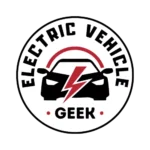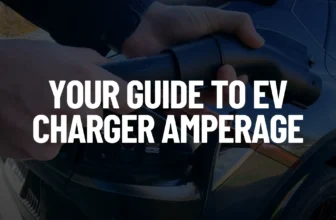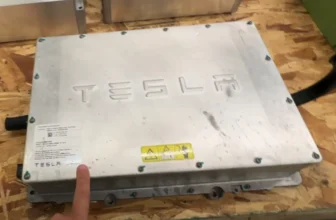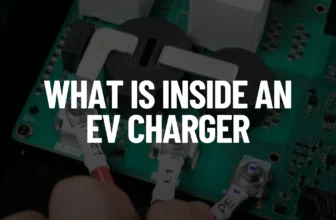Does your EV charger circuit breaker keep tripping with or without load? You will need to address the issue immediately – ignoring a tripped EV charger circuit breaker could result in major electrical damage, shock, or even fire. This guide highlights some causes, troubleshooting, and solutions to address the issue.
An electric vehicle charger circuit breaker plays an essential role in an electric vehicle’s branch circuit. It trips when there are problems in the electric vehicle branch circuit, such as EV charger wiring issues, overloaded circuit, overheated EV charger, electrical shorts, or ground fault issues in the electric vehicle branch circuit.
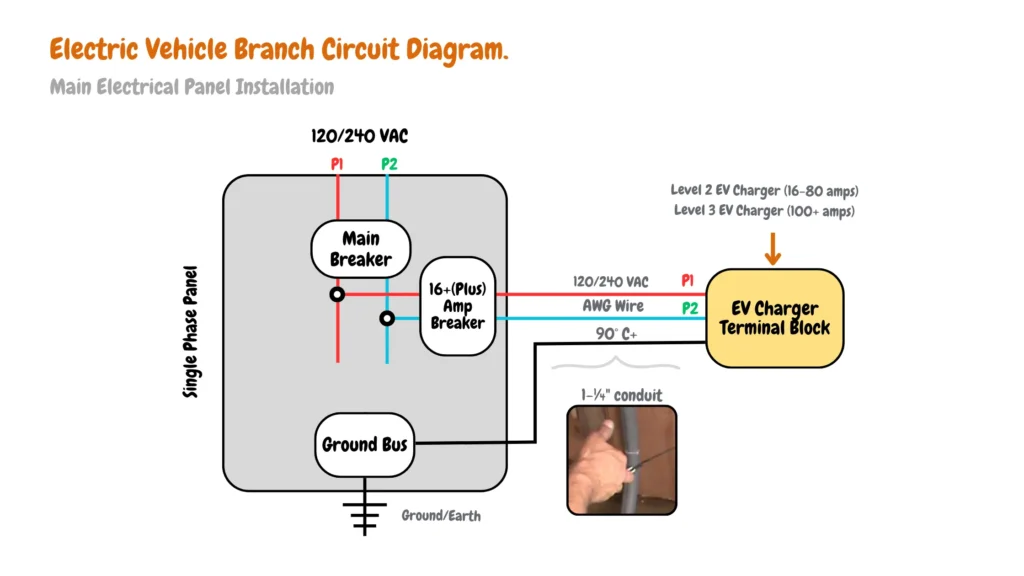
As shown in the electric vehicle branch circuit diagram above, EV charger branch circuits involve a complex interplay of electrical components. Dealing with an electric vehicle circuit breaker that keeps tripping, with or without the EV charger plugged in, pinpointing the exact culprit in the electric vehicle circuit can be frustrating.
This guide aims to simplify the process by outlining common causes and practical troubleshooting steps. Once you identify the source of the reason why your EV charger is tripping, you can safely resolve it with the help of a licensed electrician or certified EV charger installer.
Table of Contents
- Key Takeaways:
- Why Your EV Charger Circuit Breaker Keeps Tripping
- FAQ About Breakers That Keep Tripping
Key Takeaways:
- Improper wiring, poor grounding, or damaged components in the EV branch circuit can cause frequent breaker trips.
- DC leakage currents, often from the EV itself, can interfere with standard ground fault protection; use RDC-DD + Type A RCD or a Type B RCD to prevent this.
- Overloaded circuits and long feeder wires can lead to overheating and voltage drops, triggering protective shutdowns.
- Insulation degradation and worn connectors increase the risk of undetected leakage currents and should be inspected regularly.
- Installing a properly sized dedicated EV charger circuit breaker, ensuring correct EV charger grounding, and using a safety-rated EVSE with integrated protections minimizes tripping and enhances system reliability.
Why Your EV Charger Circuit Breaker Keeps Tripping
This guide covers both hardwired and plug-in EV charger installations. It addresses issues with tripping circuit breakers, whether the EV charger is connected or disconnected from the outlet. Additionally, it provides troubleshooting tips for when the charger trips the circuit breaker while charging.
Electric Vehicle Branch Circuit Wiring Issues.
Wiring issues in an electric vehicle’s branch circuit can be a problem that can lead to tripping the electric vehicle circuit breakers, especially when the EV charger is not connected.
The three common issues of wiring problems in an electrical vehicle circuit include:
Electric Vehicle Branch Circuit Current Leakage.
One of the common issues of a tripping EV charger circuit breaker when the charger is not connected includes current leakage in the electric vehicle branch circuit wiring, this can be due to one or more of the feeder wires from the main panel or to the EV charger outlet/junction box experiencing small amounts of current strays from its intended path and flows unintentionally to ground or another conductor.
This can happen for several reasons:
Electric Vehicle Branch Circuit Wire Insulation Degradation.
The wires used in your EV charger installations should be protected from heat and moisture with a conduit. Even protected EV charger installation wires over time experience wear and tear, due to heat or moisture, which can degrade the insulation of the EV charger installation cables, making them susceptible to current leakage.
Damaged Electrical Vehicle Branch Circuit Components.
Depending on the complexity of your EV charger installation you might have different components installed such as smart circuit breakers, smart meters, emergency power-off buttons, renewable energy EV charging transfer switches, and junction boxes that can develop internal leakage paths allowing current to escape, for complex EV charger installation electrical components installed in the electric vehicle branch circuit can have a minor imperfection in their installation or manufacturing process that can lead to internal current leakage.
The image below shows a complex EV charger installation involving a renewable EV charger integrated system with lots of components installed in the electric vehicle branch circuit; any damaged components in the circuit might lead to internal current leakage.

Faulty components like capacitors, transformers, or switches can develop internal leakage paths, allowing current to escape. Even new components may have minor imperfections in their installation or manufacturing process that can lead to slight leakage currents.
Poor Electric Vehicle Branch Circuit Grounding.
Poor grounding practices, such as loose connections or missing grounding wires, can create alternative paths for current flow. It’s essential to use high-quality grounding conductors, maintain secure connections, and verify grounding continuity throughout the electric vehicle’s branch circuit to prevent grounding issues from causing leakage problems that would trigger the EV charger circuit breaker to trip.

Improper EV charger ground installation can also lead to ground faults, causing the circuit breaker and potentially a Ground Fault Circuit Interrupter (GFCI) to trip.
Ground faults occur when the ungrounded (hot) conductor comes into unintended contact with the grounded circuit path (e.g., metal box, grounding wire). This creates a low-impedance path for current to flow, bypassing its intended route.
Long Electric Vehicle Branch Circuit Feeder Wires.
We recommend making sure the electrical panel is close to the point of use to mitigate voltage drops, in poorly designed electric vehicle branch circuits where the distance between the circuit breaker and the EV charger is long, or the distance between the dedicated circuit breaker and main breaker is long, this can lead to leakage of current.
It’s crucial to ensure that the wire capacities are sufficient to handle the current flow without any risk of leakage in the current configurations.
DC Leakage Due to Insulation Degradation, Damaged Cables, Worn Connectors
DC leakage in EV charging systems is a fault condition; it occurs when direct current (DC) unintentionally flows through parts of the system designed for alternating current (AC) only. This often results from insulation degradation, damaged cables, worn connectors, or internal faults in the EV or its onboard charger.
When such leakage occurs, the EV charger circuit breaker can, and should, trip. This is not a malfunction of the breaker, but a critical safety mechanism designed to prevent electric shock. EV charging introduces the risk of smooth DC leakage currents, which standard Type A Residual Current Devices (RCDs) are not equipped to detect.
How to Fix Electric Vehicle Branch Circuit Current Leakage.
To fix the electric vehicle branch circuit current leakage, you will first need to identify the source of the current leakage in your electric vehicle branch circuit. You can start by:
- Visual inspection of the electric vehicle branch circuit wires, junction boxes, connections, and splices, electrical components in the electric vehicle branch circuits, and other connections for signs of damage.
- If you happen to own devices that can detect and diagnose current leakage in electric systems such as a multimeter, clamp meter, insulation resistant tester (Megohmmeter), earth leakage circuit breaker tester, or a ground fault circuit interrupter (GFCI) tester, can use them to specifically detect the exact components in the electric vehicle branch circuit with a current leakage causing your electric vehicle circuit breaker to trip.
- Visual inspection alone can’t diagnose current leakage in your EV charger circuit. Degraded insulation or faulty components might be the culprit, requiring specialized tools that electricians possess. Seek professional help for a definitive diagnosis and lasting solution to prevent future tripping of your EV charger circuit breaker.
If your EV charger circuit breaker keeps tripping unexpectedly, the issue may be caused by undetected DC leakage interfering with upstream ground fault protection.
Higher-end EV chargers often include an integrated DC leakage detector (RDC-DD) as part of their EV charger safety features, capable of sensing smooth DC fault currents ≥6mA. When paired with a standard Type A RCD (30mA trip sensitivity), this setup maintains effective AC fault protection without nuisance tripping.
However, if your charger lacks an RDC-DD, a more advanced Type B RCD is required. Type B devices detect AC, pulsating DC, and smooth DC leakage, offering the most complete fault protection. Though more expensive, they are far less prone to nuisance tripping, making them a smart upgrade for homes experiencing repeat breaker interruptions during EV charging.
Overheating EV Charger
When an EV charger overheats, it draws excessive current. This increased current flow trips the EV charger circuit breaker, cutting power to the charger and preventing further damage. Under such circumstances, a tripped breaker serves as a crucial safety measure.
An overheating EV charger can result from a manufacturing defect or human error during electric vehicle charging.
Manufacturing issues that can cause EV chargers to overheat include faulty internal components within the charger or charging cable, such as damaged circuitry and wires that impede efficient heat dissipation and may lead to current leakage, causing your EV charger circuit breaker to trip.
The diagram below illustrates the components of a typical EV charger and their role in preventing overheating. These components may include thermal monitoring devices that can trigger the circuit breaker to trip if excessive heat is detected.
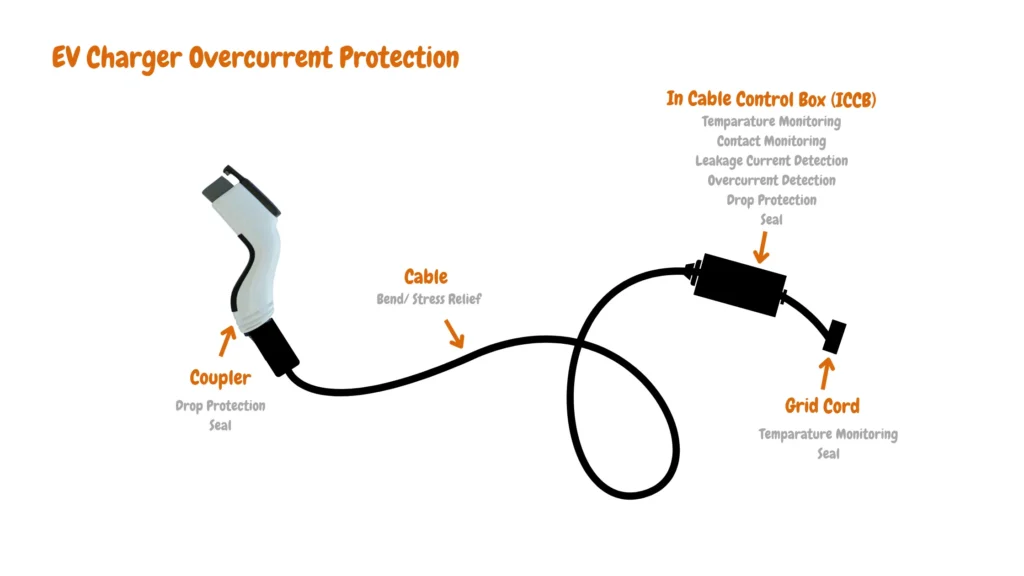
Human errors that can lead to EV charger overheating include using the charger in enclosed spaces or obstructing the EV charger’s ventilation vents, which trap heat inside. EV chargers require adequate airflow to dissipate the heat generated during operation. Additionally, using the charger on a circuit already burdened by other appliances can overload the system, causing overheating of the charger and circuit components.
Other issues that can cause your EV charger to overheat when charging your electric vehicle causing the circuit breaker to trip include poor installation of the EV charger, some of the common issues relating to poor EV charger installation include loose connection and splices, and undersized EV charger wiring can create resistant points that can cause the electrical vehicle branch circuit components including the EV charger to generate excess heat especially when the EV charger is being used (loaded).
How to Prevent Your EV Charger From Overheating.
You can prevent your EV charger from overheating when using the EV charger which can cause the EV charger circuit breaker to trip by taking the following precautionary measures to minimize the risk of the EV charger from overheating and prevent your EV charger circuit breaker from tripping.
- Ensure Proper Ventilation: Maintain adequate clearance around the charger and avoid blocking vents. Consider installing the charger in a well-ventilated location.
- Keep Your EV Charger Clean: Regularly clean the EV charger with a dry cloth to remove dirt, dust, oil, and grease that can accumulate on the EV charger’s ventilation and connection points.
- Regular Maintenance: Schedule periodic inspections of the EV charger and the electric vehicle branch circuit by a qualified electrician to identify potential issues such as wiring problems, loose connections, and other issues, and ensure the overall EV charging system is in optimal condition.
- Qualified Installation: Contact a licensed electrician to install your EV charger to ensure adherence to safety codes and proper sizing of electrical components.
- Monitor Circuit Load: Avoid using the EV charger on a circuit already loaded with other appliances. Distribute your electrical load efficiently.
Electric Vehicle Branch Circuit Overloaded Circuit.
When the electric vehicle charger attempts to draw more power than the capacity of the branch circuit, it causes the wires and electrical components to heat up. This overheating triggers the EV circuit breaker to trip, serving as a safety measure for overcurrent protection during electric vehicle charging.

Some of the signs your electric vehicle branch circuit is overloaded apart from the tripping EV charger circuit breaker includes, slow EV charging speeds, flickering or dimming indicator lights and display of the EV charger, EV charger not charging even after being plugged in, buzzing or humming sounds from the electrical panel housing the circuit breaker, burning smells terminating from any components of the electric vehicle branch circuit, warm to touch wires.
Preventing Overloaded EV Charger Circuits.
- EV Charger Compatibility: EV charger compatibility requires a three-pronged approach. First, ensure the charger’s output matches your EV’s charging needs (voltage, current, connector type). Second, verify the charger’s voltage and current requirements align with your electrical system’s capacity (circuit breaker rating, wire gauge). Finally, confirm the charger adheres to compatible EV charging protocols (J1772 for AC, CCS Combo, or CHAdeMO for DC fast charging) for seamless communication with your EV.
- Check Your Electric Panel Load: Check your electrical panel rating and its load, check for devices that are connected to the same electrical panel that might cause the electrical panel to overload, and stop their processes to reduce the overall power demand of the main electrical panel.
- Install Dedicated Circuits: Not only does your EV charger need to be connected to a dedicated circuit breaker, but other high-powered devices connected to the same electrical panel should have a dedicated circuit breaker to reduce the chances of the electrical panel overloading
FAQ About Breakers That Keep Tripping
If your EV charger circuit breaker keeps tripping, you’re not alone. Breakers are a built-in safety feature designed to protect your EV charging system from electrical hazards. However, a tripped breaker can be frustrating and confusing, especially for EV owners unsure of the cause or how to fix it.
To help you troubleshoot effectively, we’ve compiled answers to the most frequently asked questions about EV charger breaker trips. Whether you’re dealing with installation issues, DC leakage, or overloaded circuits, this guide will help you understand the root causes and ensure your EV charging setup remains safe and reliable.
Can an EV Charger Circuit Breaker Go Bad if It Keeps Tripping?
How Do You Know if an EV Charger Circuit Breaker Is Bad?
What Usually Causes an EV Charger Circuit Breaker to Trip?
How Do You Fix an EV Charger Circuit Breaker That Keeps Tripping?
Identify the cause by isolating the EV charger. If the breaker still trips, it likely points to an overloaded circuit, requiring a qualified electrician to assess capacity.
For potential ground faults, short circuits, or internal EV charger issues, a professional can diagnose and fix the root cause for safe and reliable EV charging. Remember, a tripping breaker is a safety feature – prioritize the cause, not just replacing the tripping EV charger circuit breaker
Why Might My Tesla Charger Breaker Trip?
First, it could be a circuit overload situation where the charger draws more current than the circuit can safely handle, especially if other appliances are also on the same circuit or if the charger’s current demand exceeds the circuit’s rating.
Second, improper installation or damaged wiring can cause ground faults, creating unintended paths for current to flow to the ground and triggering the breaker’s protective mechanism.
Finally, internal malfunctions within the Tesla charger itself, such as excessive current draw or ground faults, can also lead to breaker tripping.
These factors highlight the importance of ensuring proper circuit capacity, installation practices, and equipment condition for reliable operation of your Tesla charger.

James Ndungu is a certified EV charger installer with over five years of experience in EVSE selection, permitting, and installation. He holds advanced credentials, including certification from the Electric Vehicle Infrastructure Training Program (EVITP) and specialized training in EV charging equipment and installation, as well as diplomas in EV Technology and Engineering Fundamentals of EVs. Since 2021, James has tested dozens of EV chargers and accessories, sharing expert insights into the latest EV charging technologies.
